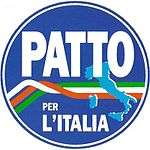Pact for Italy
Pact for Italy Patto per l'Italia | |
|---|---|
 | |
| Leader |
Mariotto Segni Mino Martinazzoli |
| Founded | January 1994 |
| Dissolved | March 1994 |
| Political position | Centre |
The Pact for Italy (Italian: Patto per l'Italia) was a centrist political and electoral alliance in Italy launched by Mario Segni and Mino Martinazzoli in 1994.[1][2]
History
The alliance was composed of the Italian People's Party (PPI, the successor to Christian Democracy) and the Segni Pact.[3] The alliance also included remnants of the Italian Republican Party (PRI).[4] The alliance finished third place in the 1994 general election, behind the centre-right Pole of Freedoms/Pole of Good Government and the left-wing Alliance of Progressives. The alliance returned 33 seats in the Chamber of Deputies.[5]
Originally Lega Nord was also to join the alliance, but LN leader Umberto Bossi decided to join Silvio Berlusconi's Pole of Freedoms instead.
After the election, the alliance was disbanded. The PPI suffered a split of those who wanted to join Berlusconi's centre-right (the United Christian Democrats of Rocco Buttiglione) and those who wanted to ally with the left-wing Democratic Party of the Left. Segni Pact become a minor force and formed a joint list, within the centre-left coalition The Olive Tree, with Italian Renewal and the Italian Socialists for 1996 general election called the Pact of Democrats.[6]
Composition
It was composed of the following political parties:
| Party | Ideology | Leader | |
|---|---|---|---|
| Italian People's Party (PPI) | Christian democracy | Mino Martinazzoli | |
| Segni Pact (PS) | Christian liberalism | Mariotto Segni | |
| Italian Republican Party (PRI) | Liberalism | Giorgio La Malfa | |
Electoral results
| Chamber of Deputies | |||||
| Election year | # of overall votes |
% of overall vote |
# of overall seats won |
+/– | Leader |
|---|---|---|---|---|---|
| 1994 | 6,019,038 (#3) | 15.63 | 46 / 630 |
|
|
| Senate of the Republic | |||||
| Election year | # of overall votes |
% of overall vote |
# of overall seats won |
+/– | Leader |
|---|---|---|---|---|---|
| 1994 | 5,526,090 (#3) | 16.69 | 31 / 315 |
|
|
References
- ↑ David Broughton (1999). Changing Party Systems in Western Europe. Continuum International Publishing Group. p. 78. ISBN 978-1-85567-328-1. Retrieved 20 August 2012.
- ↑ Leonardo Morlino (1995). "Political Parties and Democratic Consolidation in Southern Europe". In Richard Gunther; Nikiforos P. Diamandouros; Hans-Jürgen Puhle. The Politics of Democratic Consolidation: Southern Europe in Comparative Perspective. JHU Press. p. 378. ISBN 978-0-8018-4982-4.
- ↑ Guido Ortona; Stefania Ottone; Ferruccio Ponzano (2007). "A simulative assessment of the Italian electoral system". In Fabio Padovano; Roberto Ricciuti. Italian Institutional Reforms: A Public Choice Perspective: A Public Choice Perspective. Springer. p. 34. ISBN 978-0-387-72141-5.
- ↑ Stephen P. Koff (2013). Italy: From the 1st to the 2nd Republic. Routledge. p. 243. ISBN 978-1-134-64369-1.
- ↑ Aldo di Virgilio; Steven R. Reed (2011). "Nominating Candidates Under New Rules in Italy and Japan: You Cannot Bargain with Resources You Do Not Have". In Daniela Giannetti; Bernard Grofman. A Natural Experiment on Electoral Law Reform: Evaluating the Long Run Consequences of 1990s Electoral Reform in Italy and Japan. Springer Science & Business Media. p. 83. ISBN 978-1-4419-7228-6.
- ↑ André Krouwel (2012). Party Transformations in European Democracies. SUNY Press. p. 323. ISBN 978-1-4384-4481-9.